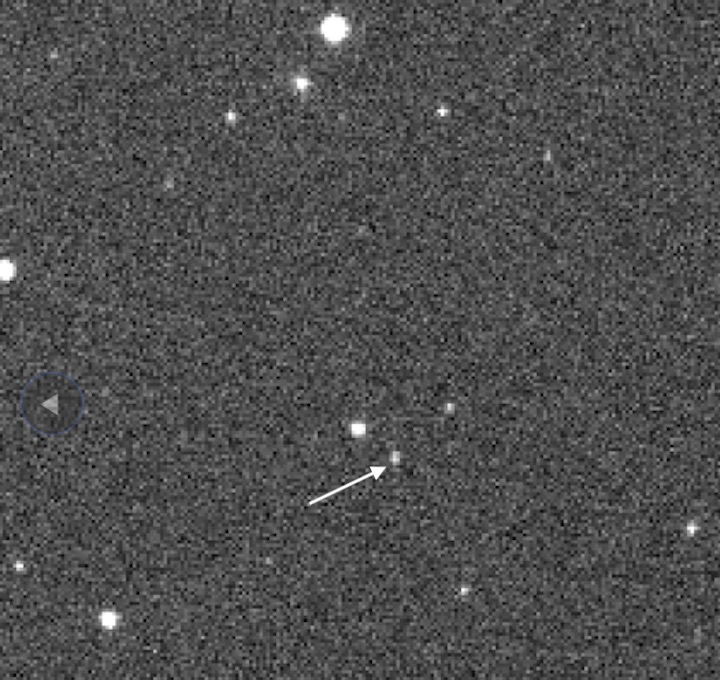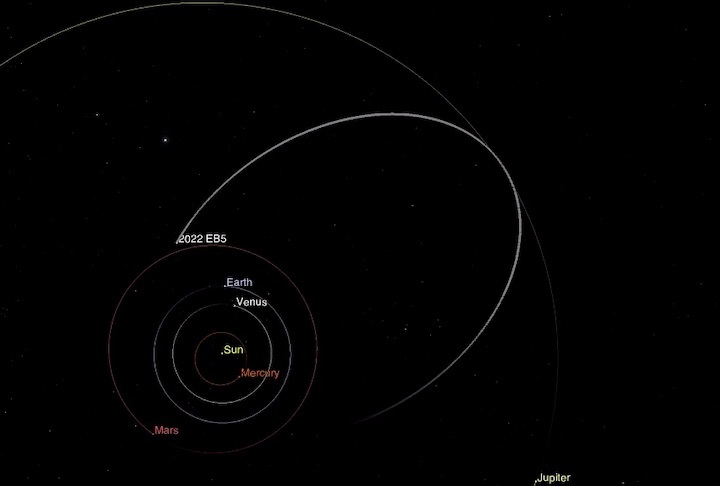16.03.2022
It was "probably a once-in-a-lifetime" moment for the asteroid hunter.

This weekend, an astronomer spotted a small asteroid just hours before the space rock crashed into Earth's atmosphere and met its fiery demise.
On Friday (March 11), astronomer Krisztián Sárneczky was observing the sky at the Piszkésteto Mountain Station, which is part of the Konkoly Observatory near Budapest in Hungary. During his observations, he spotted an asteroid, now dubbed 2022 EB5 by the Minor Planet Center. Scientists estimate that the space rock was about 10 feet (3 meters) wide (no big deal for an asteroid).
But the sighting soon got a lot more interesting: Just 30 minutes after the discovery, data showed that the space rock was a mere two hours away from colliding with Earth's atmosphere.
This is "probably a once in a lifetime" experience for an "asteroid hunter," Sárneczky told Space.com. Sárneczky has been searching regularly for near-Earth asteroids at Piszkésteto since August 2020, he told Space.com.
The asteroid struck Earth's atmosphere just north of Iceland at 5:22 p.m. EST (2222 GMT) on Friday, Earthsky.org reported. Scientists estimated that 2022 EB5 was traveling at about 39,600 miles per hour (66,600 kilometers per hour), slower than Earth's speed in orbit of about 64,800 mph (108,000 km/h).
2022 EB5 looked like "a star-like, fast-moving object shifting against the background stars. Like a normal near-Earth asteroid," Sárneczky said, additionally sharing that this was the 64th near-Earth object he had discovered.
Experts believe the space rock burned up in our atmosphere, creating a bright meteor often referred to as a fireball, or shooting star, in the sky. Because of the asteroid's small size, it is highly unlikely that the space rock survived the journey. Most likely, it completely burned up in Earth's atmosphere and at this time, no resulting meteorite has been found.
According to amateur astronomer and orbital simulation expert Tony Dunn, the discovery of 2022 EB5 before its collision was a rare event.
"Impact! When 2022 EB5 struck the Earth north of Iceland this morning, it became the 5th asteroid to be discovered prior to impacting Earth," Dunn tweeted along with an animated simulation of the asteroid crashing into our planet.
The other four asteroids that have been spotted before impact include 2014 AA, 2018 LA, 2008 TV2 and 2019 MO, according to Earthsky.org.
There have been a few reports of people in Iceland who claim to have seen a bright flash of light that could have coincided with the meteor impact, according to Earthsky.org. However, there has been no conclusive visual or video detections of the fireball, "likely due to the remoteness of the impact location," according to a statement from the European Space Agency.
Still, thanks to data from an international network of infrasound detectors, there is independent evidence of the asteroid's impact. With these detectors, signals from the impact were observed from both Iceland and Greenland, according to the ESA statement.
The International Meteor Organization is currently accepting public reports of observations of the fireball. So if you live in Iceland or Norway and think you may have witnessed this fireball, report your sighting here.
Quelle: Space.com
+++
NASA System Predicts Impact of Small Asteroid

This animation shows asteroid 2022 EB5's predicted orbit around the Sun before impacting into the Earth’s atmosphere on March 11, 2022. The asteroid – estimated to be about 6 ½ feet (2 meters) wide – was discovered only two hours before impact.
Asteroid 2022 EB5 was too small to pose a hazard to Earth, but its discovery marks the fifth time that any asteroid has been observed before impacting into the atmosphere.
A small asteroid hit Earth’s atmosphere over the Norwegian Sea before disintegrating on March 11, 2022. But this event wasn’t a complete surprise: Astronomers knew it was on a collision course, predicting exactly where and when the impact would happen.
Two hours before the asteroid made impact, K. Sarneczky at the Piszkéstető Observatory in northern Hungary first reported observations of the small object to the Minor Planet Center – the internationally recognized clearinghouse for the position measurements of small celestial bodies. The object was posted on the Minor Planet Center’s Near-Earth Object Confirmation Page to flag it for additional observations that would confirm it as a previously unknown asteroid.
NASA’s “Scout” impact hazard assessment system then took these early measurements to calculate the trajectory of 2022 EB5. As soon as Scout determined that 2022 EB5 was going to hit Earth’s atmosphere, the system alerted the Center for Near Earth Object Studies (CNEOS) and NASA’s Planetary Defense Coordination Office, and flagged the object on the Scout webpage to notify the near-Earth object observing community. Maintained by CNEOS at NASA’s Jet Propulsion Laboratory in Southern California, Scout automatically searches the Minor Planet Center’s database for possible new short-term impactors. CNEOS calculates every known near-Earth asteroid orbit to improve impact hazard assessments in support of the Planetary Defense Coordination Office.
“Scout had only 14 observations over 40 minutes from one observatory to work with when it first identified the object as an impactor. We were able to determine the possible impact locations, which initially extended from western Greenland to off the coast of Norway,” said Davide Farnocchia, a navigation engineer at JPL who developed Scout. “As more observatories tracked the asteroid, our calculations of its trajectory and impact location became more precise.”
Fully interactive, Eyes on Asteroids uses science data to help visualize asteroid and comet orbits around the Sun. Zoom in to travel along with your favorite spacecraft as they explore these fascinating near-Earth objects in beautiful 3D.
Scout determined that 2022 EB5 would enter the atmosphere southwest of Jan Mayen, a Norwegian island nearly 300 miles (470 kilometers) off the east coast of Greenland and northeast of Iceland. At 5:23 p.m. EST (2:23 p.m. PST), 2022 EB5 hit the atmosphere as predicted by Scout, and infrasound detectors have confirmed the impact occurred at the predicted time.
From observations of the asteroid as it approached Earth and the energy measured by infrasound detectors at time of impact, 2022 EB5 is estimated to have been about 6 1/2 feet (2 meters) in size. Tiny asteroids of this size get bright enough to be detected only in the last few hours before their impact (or before they make a very close approach to Earth). They are much smaller than the objects that the Planetary Defense Coordination Office is tasked by NASA with detecting and warning about.
“Tiny asteroids like 2022 EB5 are numerous, and they impact into the atmosphere quite frequently – roughly every 10 months or so,” said Paul Chodas, the director of CNEOS at JPL. “But very few of these asteroids have actually been detected in space and observed extensively prior to impact, basically because they are very faint until the last few hours, and a survey telescope has to observe just the right spot of sky at the right time for one to be detected.”
A larger asteroid with hazardous impact potential would be discovered much farther from Earth. NASA’s goal is to keep track of such asteroids and to calculate their trajectories in order to have many years’ notice ahead of a potential impact should one ever be identified. But this real-world event with a very small asteroid allowed the planetary defense community to exercise capabilities and gave some confidence that the impact prediction models at CNEOS are highly capable of informing the response to the potential impact of a larger object.
2022 EB5 is only the fifth small asteroid to be detected in space before hitting Earth’s atmosphere. The first asteroid to be discovered and tracked well before hitting Earth was 2008 TC3, which entered the atmosphere over Sudan and broke up in October 2008. That 13-foot-wide (4-meter-wide) asteroid scattered hundreds of small meteorites over the Nubian Desert. As surveys become more sophisticated and sensitive, more of these harmless objects will be detected before entering the atmosphere.
Quelle: NASA
